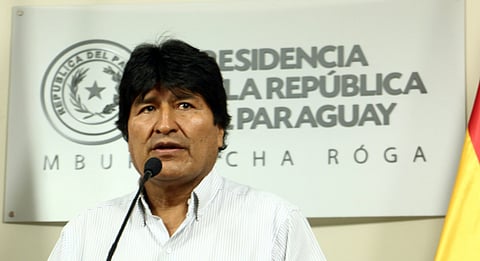Evo Morales — A Mexican standoff in Bolivia
Former Bolivian president who is in self-exile in Mexico promises to return

When you’ve been the leader of any group, organisation or nation for almost 14 years, you’re bound to have left a pretty big hole to fill.
And that’s exactly the case in Bolivia where former president Evo Morales has been unseated but is now watching very closely from the wings in Mexico as security forces on the streets of La Paz clashed with his many supporters — a very taxing and testing start to the new rule of interim leader Jeanine Anez.
With Morales thousands of kilometres away in Mexico City, after he resigned under pressure on Sunday, crowds of his supporters carrying colorful flags and banners marched in the capital while his party’s lawmakers looked to unseat the Senate vice-president who stepped in on Tuesday.
Anez, 52, said she wanted elections as soon as possible and denied a coup had taken place against leftist leader and newly-exiled Morales, who hinted he could return to Bolivia.
Morales’ 14-year socialist rule ended in violent protests and recriminations after rising pressure over accusations of vote rigging in the October 20 election. But he struck a defiant tone from Mexico, where he is seeking asylum.
Anez, who has already overhauled some of Morales’ policies, faces a challenge from lawmakers of Morales’ Movement for Socialism (MAS) party, who have a majority in parliament and have threatened a rival session to nullify her presidency.
But the biggest question mark over the elections centres on a suspicious halt in the recount. With a little over 80 per cent of the vote in, and Morales holding a slight lead but losing steam, the official vote count inexplicably stopped for a full dayMick O'Reilly
Morales has never been short of colourful words and, true to form, labelled Anez as “a coup-mongering right-wing senator” and said he only stepped aside to prevent further bloodshed, adding she was responsible to the “sneakiest, most nefarious coup in history”.
Juan Evo Morales Ayma was born in a rural village, in the western Oruro region, into a family from the Aymara indigenous group 60 years ago. He cut his political teeth as the leader of a union of coca growers. Coca, the raw ingredient of cocaine, has been used in the Andes for thousands of years for religious purposes as well as to combat altitude sickness and as a mild stimulant.
Morales first ran for president in 2002, promising to govern in favour of Bolivia’s indigenous people, who had suffered centuries of marginalisation and discrimination.
While not successful at first, he won the top job on his second attempt in December 2005. He belied initial fears over his socialist bent and eventually presided over a period of strong economic growth, fuelled by the country’s natural gas riches and appetite for commodities from countries like China.
An avowed socialist, he cut his own salary and the salaries of those in his cabinet shortly after taking office and began re-nationalising oil and gas industries.
The administration invested heavily in public works projects and social programmes to fight poverty. Those left-wing policies worried and in some cases antagonised many middle-class Bolivians who saw him as too radical.
His critics also accuse him of failing to tackle corruption, which many Bolivians named as their main concern in the most recent presidential election.
The Bolivian Constitution, like the US Constitution, limits presidents to two terms. Trouble is, when that Bolivian Constitution only took effect after Morales was in power for most of his first term, should that first term count? As far as Morales and his supporters are concerned, his first term from 2006 to 2009 shouldn’t be included.
So his second and third terms for him were his first and second. Even so, a third — or is that fourth? — term seemed out of reach, which is why Morales pushed through a constitutional amendment in 2016 to allow him to run for a third official term.
Trouble is, that proposal narrowly failed in a public referendum, rendering it moot. Undeterred, Morales appealed to his own hand-picked Supreme Court, which ruled that preventing Morales from running for president would infringe his human rights. So he decided to run again in 2019, even though there’s no constitutional grounds for that whatsoever. That was one big source of opposition anger even before the October 20 vote.
And in the vote itself, there were allegedly all sorts of fairly usual shenanigans, such as ballot stuffing at certain locations and a terrible IT protocol that included the unexplained use of an unauthorised server located abroad to handle part of the data transmission with the vote count.
But the biggest question mark over the elections centres on a suspicious halt in the recount. With a little over 80 per cent of the vote in, and Morales holding a slight lead but losing steam, the official vote count inexplicably stopped for a full day.
When it restarted, Morales had somehow snagged the overwhelming majority of the outstanding votes, while opposition candidates nosedived. That mysterious late surge gave Morales just enough cushion to avoid a runoff (either win 50 per cent of the vote or at least hold a 10-point edge over the next candidate).
Most analysts agree that a united opposition would have overcome Morales in any runoff – but there wasn’t one. And right now, Anez is in power while Morales fumes from afar in Mexico City – a Mexican standoff indeed.
— With inputs from agencies and the BBC
Sign up for the Daily Briefing
Get the latest news and updates straight to your inbox



